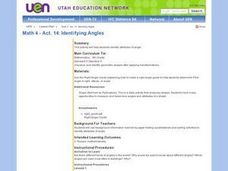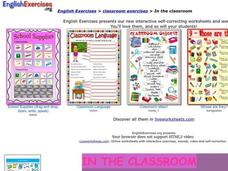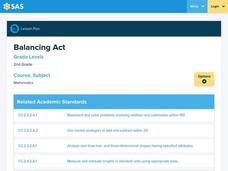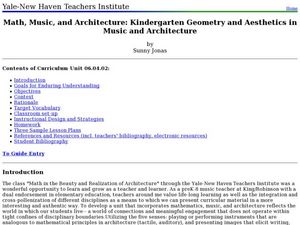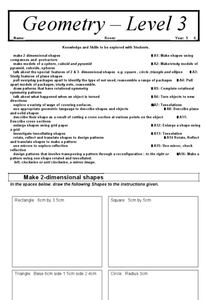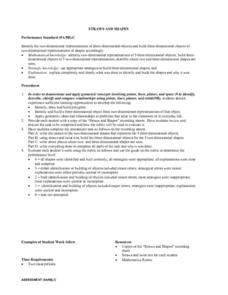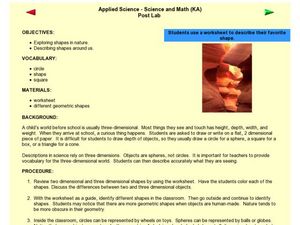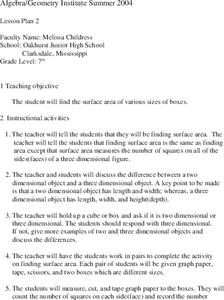Curated OER
Identifying Angles
Fourth graders discuss and examine examples of the different types of angles. After learning the names of the geometric shapes students identify the types of angles and then complete the Kidspiration activity, Identifying Angles.
Curated OER
May the Force Be With You
Third graders participate in a variety of hands-on activities that involve the effects of force on an object: What a Load, Over the Edge, Collision Zone, and Straw Rocket. They practice describing and comparing attributes of...
Curated OER
In the Classroom
In this classroom objects vocabulary worksheet, students complete 30 interactive examples. They match the names of classroom objects to their pictures in the first 15 examples. They use drop down menus to match the names of the objects...
Curated OER
Balancing Act
Second graders identify the attributes of various shapes and estimate the weight of the objects. In this geometry lesson, 2nd graders identify the attributes of concrete objects and use a pan balance to weight them.
Curated OER
Cooler in the Shadows
Students explore Earth science by creating a scale model in class. In this shadow lesson, students research the impact the sun has on Earth shadows and complete a space science worksheet. Students create models of the Sun and Earth and...
Curated OER
Math, Music and Architecture: Kindergarten Geometry and Aesthetics in Music and Architecture
Students identify and name different geometrical shapes. In this math instructional activity, students distinguish odd from even numbers. They describe the properties of 2 and 3 dimensional objects.
Curated OER
Circles to Spheres
Students investigate circles and spheres. In this space shapes lesson, students compare and contrast two-dimensional and three-dimensional shapes. Students investigate the relationship between plane and space shapes.
Curated OER
Sign Language 2 (Found Object Sculpture)
Third graders develop their symbol three-dimensionally.
Curated OER
Dimensional Analysis
Twelfth graders examine different dimensions and units which go with a particular dimension. They explore the concept of linear measurement versus area. Students estimate area of 3-D objects. They practice converting from one unit of...
Curated OER
Geometry Level 3
What a wonderful resource! Learners create two-dimensional shapes according to the instructions stated, use the squares to make a triangular prism, a cube, and a pyramid, and identify features of plane shapes, among a myriad of other...
Curated OER
Straws and Shapes
Students investigate the concepts related to observing two dimensional objects. They also build three dimensional objects using the two dimensional objects. The students give an oral or written explanation for how the pieces fit together...
Curated OER
What's My Rule for Sorting?
Students view objects sorted by one characteristic and name that characteristic. In this sorting rule lesson, students explore to find a new characteristic and write a description of that rule. In early grades the rule might...
Curated OER
Applied Science: Exploring Shapes in Nature
Explore geometry with your young mathematicians! First, have them color in different two-dimensional and three-dimensional shapes. Then take them on a walk around the classroom. Can they identify different shapes using the target...
Teach Engineering
Seeing All Sides: Orthographic Drawing
How can your draw three-dimensional figures on paper? The lesson shows pupils how to draw orthographic projections of three-dimensional figures composed of cubes. After viewing a PowerPoint presentation, they practice this skill with...
Curated OER
Explorations with Shapes
Students describe, identify and compare two-dimensional figures. They also name and demonstrate the relative position of objects using directional words. They sort and compare two-dimensional figures and three-dimensional objects...
Indian Institute of Technology
Could King Kong Exist?
The title says it all: Could King Kong exist? Investigate how increasing the dimensions of an object affects its surface area and volume to mathematically conclude whether a creature with the weight and height of King Kong could actually...
Curated OER
Comparing Measurements
Students explore measurements by completing worksheets in class. For this geometry lesson, students identify the basic measurement units in both the English and metric systems. Students analyze 2 and 3 dimensional objects and identify...
Curated OER
Surface Area
Seventh graders explore surface area. They study the difference between two and three-dimensional objects. The teacher leads a discussion about finding the surface area of different size cubes. In pairs, 7th graders use graph paper to...
Curated OER
An Introduction to Measuring Theory
Students investigate one, two and three dimensional objects. In this algebra instructional activity, students differentiate between different shapes of objects and write equations to represent each. They start with what they already know...
Curated OER
Volume of Solids: Algebra/Geometry Institute
Use this volume of solids lesson to have learners find the surface area and volume of cylinders, pyramids, and prisms. They place cubes inside three-dimensional figures to determine the volume. Worksheets and answers are provided.
Curated OER
Geometry Gymnastics
Students identify shapes and manipulate 2 and 3 dimensional objects. They view objects from different perspectives and review relative positions (near, far, between). They sing a shape song.
EngageNY
How Do 3D Printers Work?
If we stack up all the cross sections of a figure, does it create the figure? Pupils make the connection between the complete set of cross sections and the solid. They then view videos in order to see how 3D printers use Cavalerie's...
Curated OER
Using Nets to Find Surface Area
Eighth graders explore three-dimensional objects (prisms, pyramids, cylinders and cones) to draw nets. They use the understanding of drawing nets to find the surface area of pyramids and cylinders.
Curated OER
Translations, Reflections, and Rotations
High schoolers are introduced to the concepts of translation, reflection, and rotation. They practice translating, reflecting, and rotating two-dimensional objects on the coordinate plane. students use computers to learn about the three...
Other popular searches
- 3 Dimensional Objects
- Three Dimensional Objects
- Three Dimensional Objects
- Two Dimensional Objects
- 3 Dimensional Objects
- Making 3 Dimensional Objects
